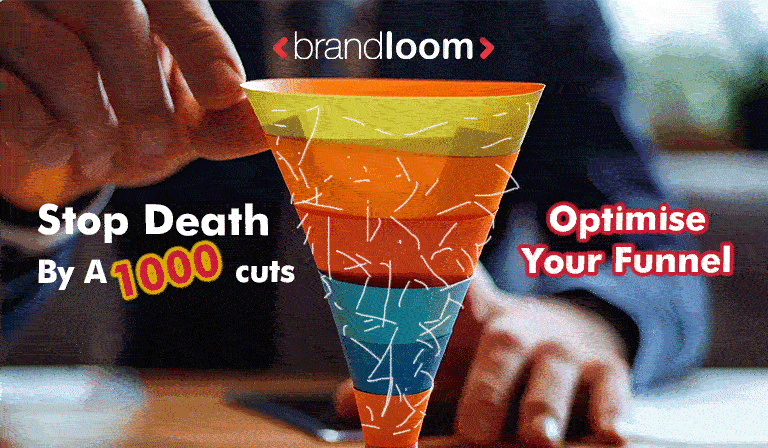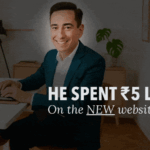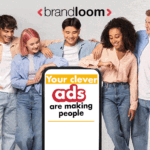Hi there,
A much-talked-about brand came to us last month.
They were spending heavily on Google and Meta ads. I’m talking about lakhs every week.
Their dashboards were lit up with impressions, clicks, reach, engagement… all the usual metrics that make a media buyer smile.
But the founder wasn’t smiling.
He called me up that evening, late, around 9:45 PM. “We’re seeing traffic,” he said, “but conversions are just not happening. Clicks are there, but no sales. Avinash, our money is going into a black hole.”
And he wasn’t wrong.
We’ve seen this before. Many times. Good brands. Solid products. But no returns from paid media. And the worst part? They don’t understand what’s wrong.
If they think the ads are the problem. They simply try throwing more money at it. Some try new creatives blindly. Others start running discounts to force sales. It becomes a cycle.
But the real issue is usually something deep.
Coming back to our story…
I asked him to send over access to his ad accounts and analytics.
Which he did.
So, the next morning, I sat with my coffee and opened up their Google and Meta dashboards.
Five minutes in, I saw the real problem.

Or should I say – problems.
It was not just one issue, but a pattern of small leaks.
– Wrong targeting.
– No exclusions.
– Generic creatives.
And the funnel had zero warmth. Cold traffic was being sent straight to product pages with no bridge in between.
– No education.
– No urgency.
– No story.
They were simply pushing products through a broken funnel—no story, no warmth, and no reason for the customer to care.
Just cold ads leading to colder pages.
No wonder conversions weren’t happening.
Here’s how we resolved his problem, step by step:
Step 1: We stopped the bleeding & revised the target.
First, the BrandLoom team paused every non-performing campaign. Anything with a low ROAS or no clear intent signal was turned off. This alone brought their ad spend down by 40% without affecting traffic quality.
We found his targeting was too wide. He was aiming for “fashion lovers in India aged 18–45.”
That’s not a buyer persona. That’s a population census!
We refined it: people who had added to the cart in the past 30 days, Instagram engagers, and returning visitors.
Step 2: We rebuilt the funnel & his offer . . .
Instead of sending cold users straight to product pages, our team introduced a warm-up sequence:
- We created a story-based video ad introducing the brand’s “why”. The viewer identifies with the brand & trust is generated.
- Then we added a lead magnet for email capture. This is based on the principle of reciprocity. Give value first.
- Finally we created a retargeting journey with value-packed carousels and testimonials that tackled buyer objections passively.
Next we modified his final offer. The original offer was “Shop now.” But that’s not really an offer—it’s a headline. Which gives the customer no reason to act.
So we rebuilt it to become sharper and more persuasive.
We added scarcity by mentioning that only a few pieces were left in a specific size. We then layered urgency by setting a clear deadline—“midnight tonight.” Finally we increased the perceived value by offering free express shipping as a small bonus.
Step 3: The landing page didn’t match the ad.
The ad they made, showed a red dress, but the landing page took users to a general women’s collection. That was confusing and unfocused for the visitor.
We fixed it by creating a clean, focused page for that exact outfit—same images, clear sizing, real reviews, and a direct checkout button. Below it, we added a few similar styles.
This made the experience clear and easy. Visitors either bought the product they came for, or went on to browse the suggested similar styles
Step 4: We fixed the product pages.
They were treating their product pages like checkout counters. So, we redesigned them to educate, compare, and then convert.
- We added persuasive headlines
- We put in trust indicators around the buy button
- Furthermore, video explainers were embedded
- Finally urgency with limited-time offers were added
Step 5: We fixed their busy checkout
You see, when their users were ready to buy, the website made them jump through hoops—no guest checkout, too many fields, and unnecessary steps. Their checkout was like a laborious form rather than a quick purchase.
So we simplified the entire process.
We removed all distractions, trimmed the steps, and built a clean, fast 2-step checkout. No login walls. No extra clicks. Just add-to-cart, and pay.
That one change alone lifted completed purchases by 18%.
Because the truth is—if buying with you feels too much work, people will quit. Even if they love the product.
Getting back to our story . . .
After we made all the changes—tighter targeting, clear messaging, a better offer, and a faster checkout, then four weeks later, I got a message from the founder.
It was simple. No long paragraphs. Just a short line on WhatsApp:
“ROAS is at 4.2x. Scaling fast.”
That was satisfying.
But if you look at we did –
– We didn’t increase his ad budget.
– We didn’t try to “hack” the algorithm.
We just fixed the customer journey.
Like I always say, fix the journey—and the sales will follow.
So If this story feels familiar to you, and if you’re also tired of watching traffic come in and money go out, it’s time we talked. You’re probably closer to scale than you think.
Just leave us a message at-
https://www.brandloom.com/advertising/ppc-package
That’s it for today, thanks for reading.
Yours Sincerely,

Avinash Chandra
Founder, BrandLoom Consulting
🌐 https://www.brandloom.com/
☎︎ +91-7669647020
📩 care@brandloom.com
💻 https://team.brandloom.com/book-a-meeting
1. Note: If you feel like talking, just hit reply on this mail.
2. Fun Fact: 82% of BrandLoom clients see an uptick of at least 20% in their revenue after the implementation of BrandLoom’s strategies.
BrandLoom Is Regularly Featured In :

Meet Us At:
Gurgaon. Mumbai. Pune. New Delhi. Bangalore. Texas. New York. London.


